
QUBIT AI: Banz & Bowinkel
Bots
FILE 2024 | Installations
International Electronic Language Festival
Bots presents a computer-controlled society through a series of algorithmically controlled humanoid avatars that appear on physical carpets using augmented reality (AR). Real-time performances synthesize human behavioral patterns into a formalized digital social study. Omnipresent, combined with our devices and incorporated into virtual environments, the work reminds us of our own digitalized world, in which we are surrounded by invisible bots.
Bio
Giulia Bowinkel (born 1983) and Friedemann Banz (born 1980) live in Berlin and have worked together under the name Banz & Bowinkel since 2009. In 2007 they graduated from the Art Academy with Albert Oehlen and started making art with computers . His work encompasses computer-generated imagery, animation, augmented reality, virtual realities and installations.
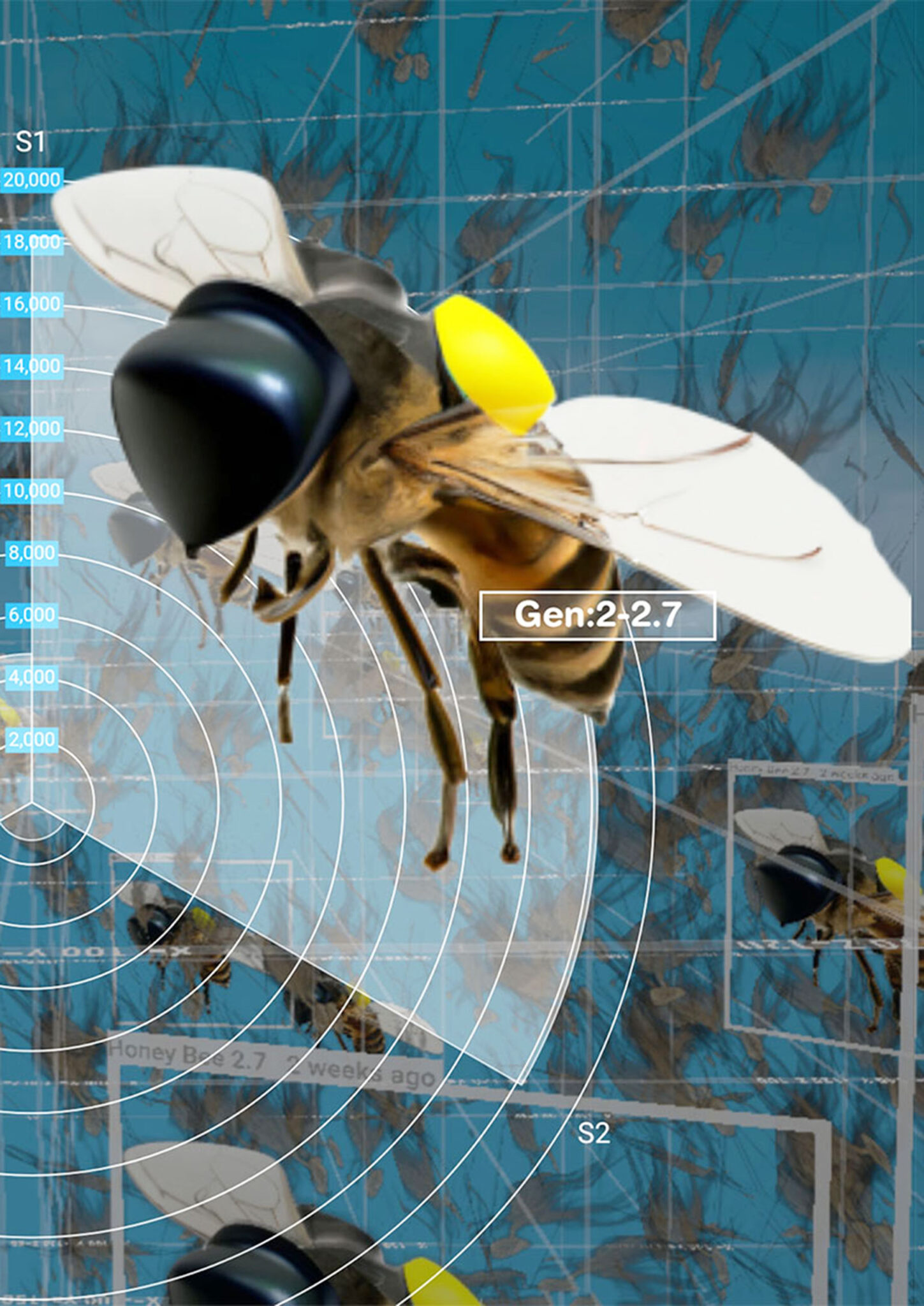
QUBIT AI: Marc Lee & Shervin Saremi
Speculative Evolution, Prototype 1
FILE 2024 | Installations
International Electronic Language Festival
Speculative experiment on a future ecosystem under strict control. The narrative takes place in a simulation, 30 years in the future, where artificial intelligence and synthetic biology collaborate to optimize an environment for cultivated species. An AI-powered simulator helps visitors generate new species to balance the ecosystem. Inspiration comes from the book Under the White Sky by Elizabeth Kolbert and artists’ stories about life on a damaged planet.
Bio
Marc Lee is a Swiss artist focused on real-time rendered audiovisual installations, AR, VR and mobile applications, critically exploring creative, cultural, social, ecological, political and speculative themes. His work has been exhibited in important museums and new media art spaces. Shervin Saremi is an Iranian musician and audio engineer specializing in sonic computing, procedural sound design and production. Currently researching immersive audio at UdK Berlin.

QUBIT AI: Luigi Novellino (aka PintoCreation)
Blob Alien Mouth
FILE 2024 | Interator – Sound Synthetics
International Electronic Language Festival
Luigi Novellino (aka PintoCreation) – Blob Alien Mouth – Italy
The journey begins with Deforum, using the Automatic1111 interface to create basic images with the StableDiffusion XL, EndjourneyXL, and Lora XLFullArt templates. The video undergoes a transformation using the Absolute Reality model and Lora Aurora style, guided by the IPAdapter node and refined by QrCode Controlnet.
Bio
Fascinated by the limitless domain of AI, Luigi Novellino adopts the title syntographer, a term that resonates deeply within the community. The artist often asks himself: “am I an artist?” Art, in his view, defies rigid definitions or limits; it represents a fluid expression of creativity that transcends labels. The artist’s ultimate goal is to awaken something in the viewer, provoking thoughts and evoking emotions.
Credits
Music: Oleh Boretskyi
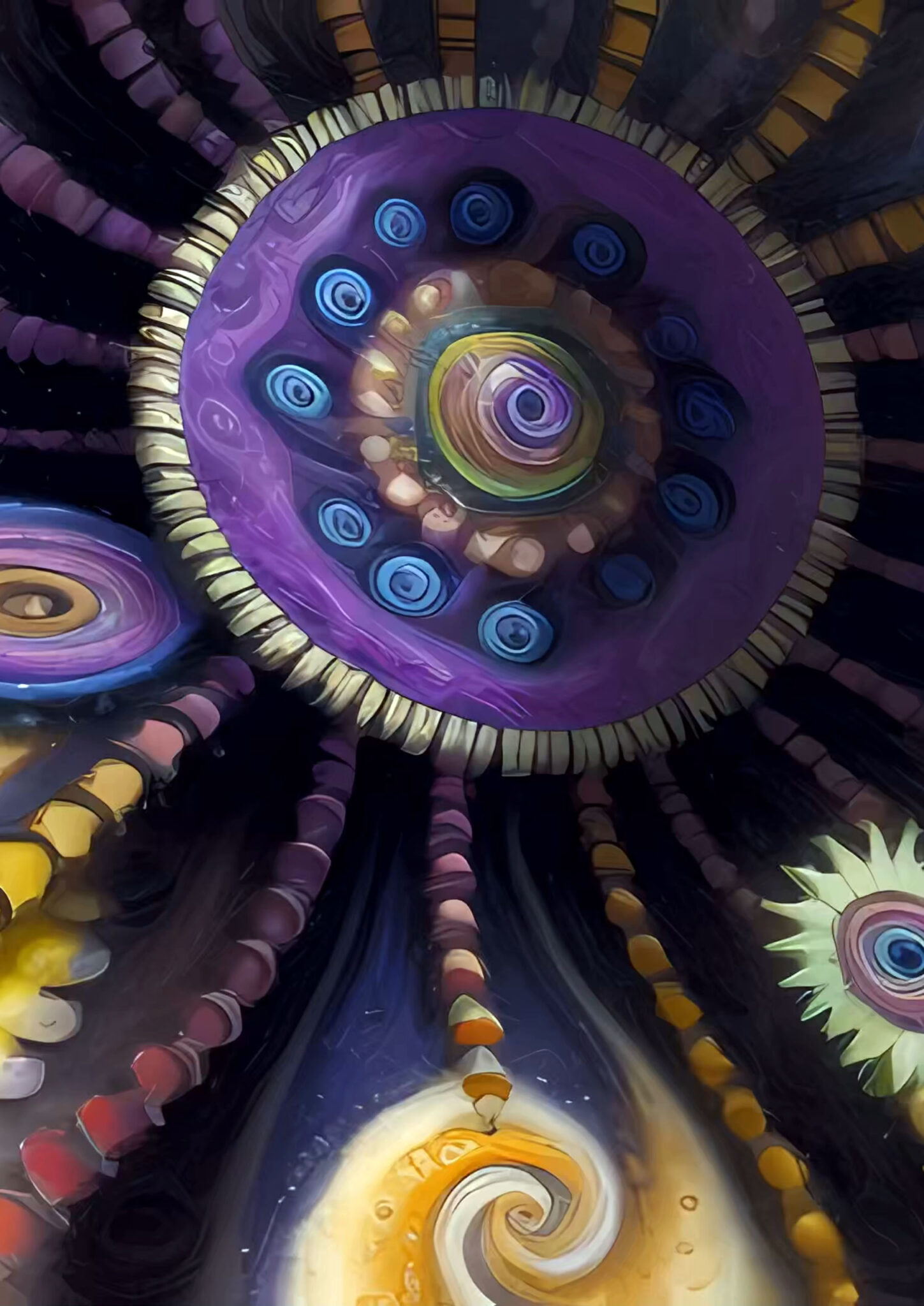
QUBIT AI: Dennis Schöneberg
Transparency
FILE 2024 | Interator – Sound Synthetics
International Electronic Language Festival
Dennis Schöneberg – Transparenza – Germany
Music controls camera settings, the weight of prompts, and the creativity of the AI. The objective of the project is to create a symbiosis between music and images, in which both elements complement and enhance each other. By directly linking musical parameters to AI creative processes, a unique audiovisual experience is created.
Bio
Dennis Schöneberg, German AI artist, data science student and developer of open source AI models, integrates his passion for electronic music into his creative endeavors. Merging art with technology, he explores the synergy between creativity and artificial intelligence.
Credits
Music: Transparenza by Michael Mayer & Reinhard Voigt

QUBIT AI: Dennis Schöneberg
Bodydub
FILE 2024 | Interator – Sound Synthetics
International Electronic Language Festival
Dennis Schöneberg – Bodydub – Germany
This video experiment combines music properties with AI generation settings to create a unique audiovisual experience. The synthesizer works as a control instrument for movement in the 3D space of the video.
Bio
Dennis Schöneberg, German AI artist, data science student and developer of open source AI models, integrates his passion for electronic music into his creative endeavors. Merging art with technology, he explores the synergy between creativity and artificial intelligence.
Credits
Music: Bodydub (Bangkok Impact Remix) by Unit4

VTOL
ADAD
This installation is a mechanism that serves as a kind of interface between planetary processes and an audience. It consists of 12 transparent piezocrystals, grown especially for the project, and 12 motorized hammers that strike them. The installation is connected to the internet. Its core algorithm is controlled by data from a meteorological site which shows lightning strikes in real time (on average, 10~200 lightning flashes occur on the planet every minute). Each time the installation receives information about a lightning strike, a hammer strikes one of the crystals, resulting in a small electrical discharge produced by the crystal under mechanical stress. Each of these charges activates a powerful lamp and sound effects.

Soichiro Mihara
三原 聡一郎
The Blank to Overcome
file festival
Part of the ”blank” project that the artist has been creating since 2011, “The Blank to Overcome” utilizes air pumps, power supply control circuitry, water, solution, glycerin, ethanol and electricity to produce bubbles in the air. The theme of ”blanks” denotes a space for an unsolved ”inquiry” through the perspectives for thinking about the post-3.11 present: how the bubbles are always shifting as a giant cluster, almost without mass or structure, and the facing up to this; and the framework since modernity that has prescribed society, and the ”involved” or the ”other”. From this work debate will surely emerge.
.
克服するための空白
アーティストが2011年から作成している「ブランク」プロジェクトの一部である「TheBlankto Overcome」は、エアポンプ、電源制御回路、水、溶液、グリセリン、エタノール、電気を利用して空気中に気泡を生成します。 「空白」のテーマは、3.11以降の現在について考えるための視点を通して、未解決の「問い合わせ」のためのスペースを示しています。泡は、ほとんど質量や構造がなく、巨大なクラスターとして常にシフトしており、これに直面しています。 ; そして、社会を規定してきた近代以来の枠組み、そして「関与する」または「その他」。 この仕事から議論が確実に浮かび上がるでしょう。
ポンプ


Bruce Nauman
Nature Morte
Nature Morte focuses on Nauman’s long relationship to his own studio, a variation on his four unique multi-projection videos, Mapping the Studio (2001). Three viewing stations, each consisting of an iPad linked to a wall-sized projection, provide an interactive exploration of the 3D studio space. Only now the artist is absent, and the participant becomes performer as he/she manipulates the large scale video projections on an iPad using touch control. The participant is free to navigate anywhere throughout the space, selecting broad vistas or individual objects. Using a hand-held 3D scanner, Nauman recorded hundreds of images that allow participants to select an object and locate close-up anything found there, and further reorient the image to see an object from above and below, and at times inside-out. The resulting mobility intensifies the experience of the viewer/performer. Presenting a static, but immersive re-creation of his studio space, Nauman’s pieces once again play at the tenuous lines between the body and space, perception and physical material.

ALWIN NIKOLAIS
Noumenon
A truly universal artist, the American Alwin Nikolais (1910-1993) devoted his life to a radical form of staged art he called “dance theater.” Inspired (perhaps unconsciously) by the experiments of Bauhaus members such as Oskar Schlemmer and László Moholy-Nagy in the 1920s, Nikolais devised a style of abstract dance that encompassed costumes, stage sets, choreography, lighting, and music, all under his control. Also in 1963, Nikolais met analog synthesizer pioneer Robert Moog, who was at the time just starting his business in New York. He was fascinated by the sounds of Moog’s machines, and with the money provided by a a Guggenheim Fellowship, Nikolais bought the first ever commercially produced Moog synthesizer. It was the primary sound-source for all of Nikolais’ scores from 1963 to 1975. The instrument is now housed at the Stearns Collection of Musical Instruments at the University of Michigan in Ann Arbor.

LEO VILLAREAL
CYLINDRE
Dans cette installation étincelante intitulée Volume, l’artiste Leo Villareal a pris une poignée d’étoiles scintillantes et les a ramenées sur terre. La partie cylindrique était suspendue au plafond et contenait plus de 20 000 lampes LED en acier inoxydable réfléchissant et hautement poli, qui créaient un espace tridimensionnel dans lequel la lumière pouvait prendre vie. Les modèles d’éclairage, contrôlés par la conception du code logiciel de Villareal, se déplacent à différentes vitesses, cycles d’allumage et d’extinction et vagues de luminosité et d’obscurité. Selon un critique, « la pièce est un poème d’argile éblouissant qui attire le spectateur dans un espace abstrait profond tout en déformant la perception temporelle et visuelle. » Villareal n’est pas un débutant en matière de sculptures lumineuses étonnantes. Découvrez ce tunnel de spectacle de lumière de 200 pieds qu’il a installé sur l’allée du hall des bâtiments est et ouest de la National Gallery of Art. L’espace entre les installations de Villareal et son public est un facteur important car les spectateurs sont entrelacés avec les lumières qui pulsent tout autour.
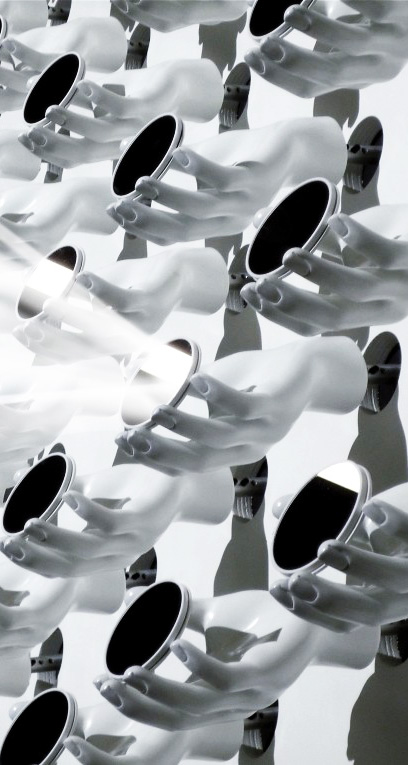
ART+COM
IN MEMORIAM
Joachim Sauter
1959-2021
R.I.P
ART+COM Studios
MOBILITY
THE INSTALLATION SPANS A CORRIDOR OF 7-METRES WIDTH. ON THE LEFT WALL ONE HUNDRED PROSTHETIC HANDS ARRANGED IN A MATRIX REVOLVE AROUND THEIR OWN VERTICAL AXIS, THE MOVEMENTS BEING CONTROLLED BY MOTORS. THE MIRRORS THEY HOLD REFLECT THE BEAM OF A STRONG LIGHT ACROSS THE SPACE AND ONTO THE OPPOSITE WALL. WHAT INITIALLY SEEMS LIKE AN ASYNCHRONOUS, CHAOTIC PATTERN OF MOVEMENT SOON REVEALS ITSELF AS A COMPLEX, COMPUTATIONAL
.
流动性
该安装跨越了7米宽的走廊。在左墙上,排列成矩阵的一百个假肢手绕其自身的垂直轴旋转,其运动由电动机控制。他们持有的镜子将强光光束反射穿过整个空间并射向对面的墙壁。最初看起来像是一个异步的,混乱的运动模式,很快就显示出一种复杂的计算编排:首先,一百个光点围绕一个中心点移动,类似于行星的天体动力学或昆虫群的飞行模式。并创造出三维空间的印象。然后突然之间,这种有机振动会聚成一个表示运动和动作的汉字。

Jakob Kudsk Steensen
Liminal Lands
Liminal Lands is an environmental multiplayer experience shared by four people at the same time. Each person transforms into the basic elements controlling life across the landscape: Algae, salt, water and mud. As they embark on a communal ritual experience, people morph and change throughout their journey, exploring each new world from a changed perspective of the landscape. Visitors move across different scales and global weather conditions, shedding their human perspective as they are pulled into six different realms inspired by the macro-landscape.

Anna Ridler
Mosaic Virus
Mosaic Virus (2018) e Mosaic Virus (2019) sono una serie di opere che raccolgono idee sul capitalismo, il valore e il crollo da diversi punti della storia. Il primo è un pezzo di immagine in movimento a schermo singolo che mostra una griglia di tulipani in continua evoluzione in fiore; la seconda un’installazione video su tre schermi, ognuno dei quali mostra un singolo tulipano. In entrambi i pezzi i tulipani sono controllati dal prezzo del bitcoin, cambiando nel tempo per mostrare come fluttua il mercato e rendendo esplicito questo collegamento. Tulipmania è stato un fenomeno del XVII secolo che ha visto il prezzo dei bulbi di tulipano aumentare e crollare: al culmine andando allo stesso prezzo di una casa di città di Amsterdam prima di scendere al prezzo di una cipolla. È spesso considerato un esempio di uno dei primi casi registrati di una bolla speculativa e si possono fare forti parallelismi con la speculazione in corso sulle criptovalute. C’è un’evidente connessione economica tra i due sistemi – entrambi sono spesso descritti come frenesie instabili – ma per me questa associazione va oltre il modo in cui i prezzi dei due si comportano su un grafico.

Kurt Hentschlager
SOL
SOL is a minimalistic environment, leading visitors into the reaches of their perception. The installation builds on loss of control, shifts in awareness and a feeling of dislocation and timelessness. SOL is the third work in an ongoing series of phenomenological environments, after the live performance FEED, 2005 and the installation ZEE, 2008. The all encompassing darkness of SOL is lifted, in intervals and for parts of seconds only, by animated bursts of intensely bright light. Falling back into darkness, visitors experience abundant retinal after-images, that gradually drift away until eventually the next eruption of light is triggered. In the surround sound-scape of SOL, electronic drones mix with swarming field recordings, amidst a sea of infra-bass.

Howeler and Yoon Architecture
Swing Time
SWING TIME est un espace de jeux interactif composé de 20 balançoires en forme d’anneau lumineux. L’installation active un parc temporaire entre le Boston Convention and Exhibition Center et D Street pour créer un espace public expérimental. Fabrication sur mesure à partir de polypropylène soudé, les balançoires sont conçus en trois tailles différentes de sorte que les spectateurs peuvent participer, le but de l’exercice, est de jouer avec SWING TIME à titre individuel ou en groupe.L’éclairage LED au sein de la balançoire est contrôlé par un micro-contrôleur personnalisé, signalisant le niveau d’activité de la balançoire. Un accéléromètre interne mesure les forces d’accélération de l’oscillation. Lorsque les forces sont statiques et les fluctuations ne sont pas utilisés, ils émettent une lumière douce, blanche qui éclaire la zone. Lorsque les balançoires sont en mouvement, le micro-contrôleur allume la lumière du blanc au violet, en créant un effet lumineux coloré.
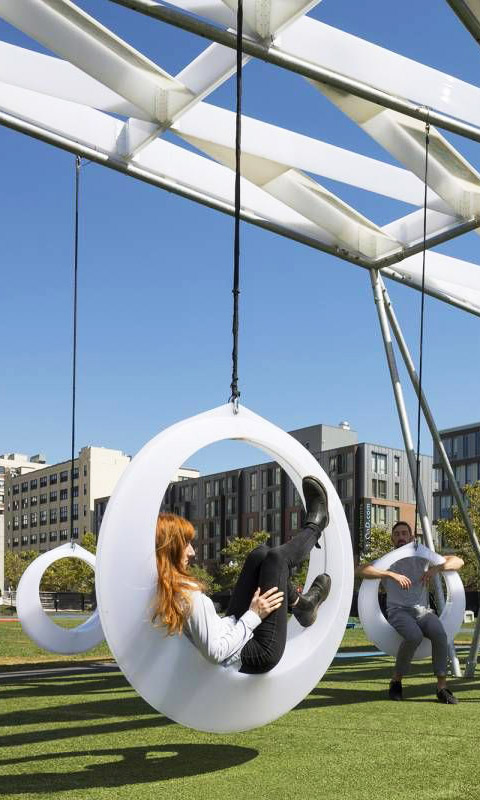
HOWELER AND YOON ARCHITECTURE
Hora do balanço
Hora do balanço é uma espaço de jogo interativo composto por 20 balanços leves em forma de anel. A instalação ativa um parque temporário entre o Centro de Convenções e Exposições de Boston e a D Street para criar um espaço público experimental. Feito sob encomenda em polipropileno soldado, os balanços são projetados em três tamanhos diferentes para que os espectadores possam participar. O objetivo do exercício é brincar com a instalação individualmente ou em grupo A iluminação LED dentro do swing é controlada por um microcontrolador personalizado, que indica o nível de atividade do swing. Um acelerômetro interno mede as forças de aceleração da oscilação. Quando as forças são estáticas e as flutuações não são usadas, elas emitem uma luz branca suave que ilumina a área. Quando as oscilações estão em movimento, o microcontrolador muda a luz do branco para o roxo, criando um efeito de luz colorido.

daniel gazana
atro enlevo
Entouré d’une atmosphère dense obtenue par la manipulation de voix de chansons anciennes et utilisant divers fragments de compositions industrielles, élaborés selon les paramètres réglables utilisés dans des logiciels spécifiques manipulés par un contrôleur MIDI, l’œuvre «Atro Enlevo» conduit l’auditeur dans l’obscurité et sortilège mystérieux.
.
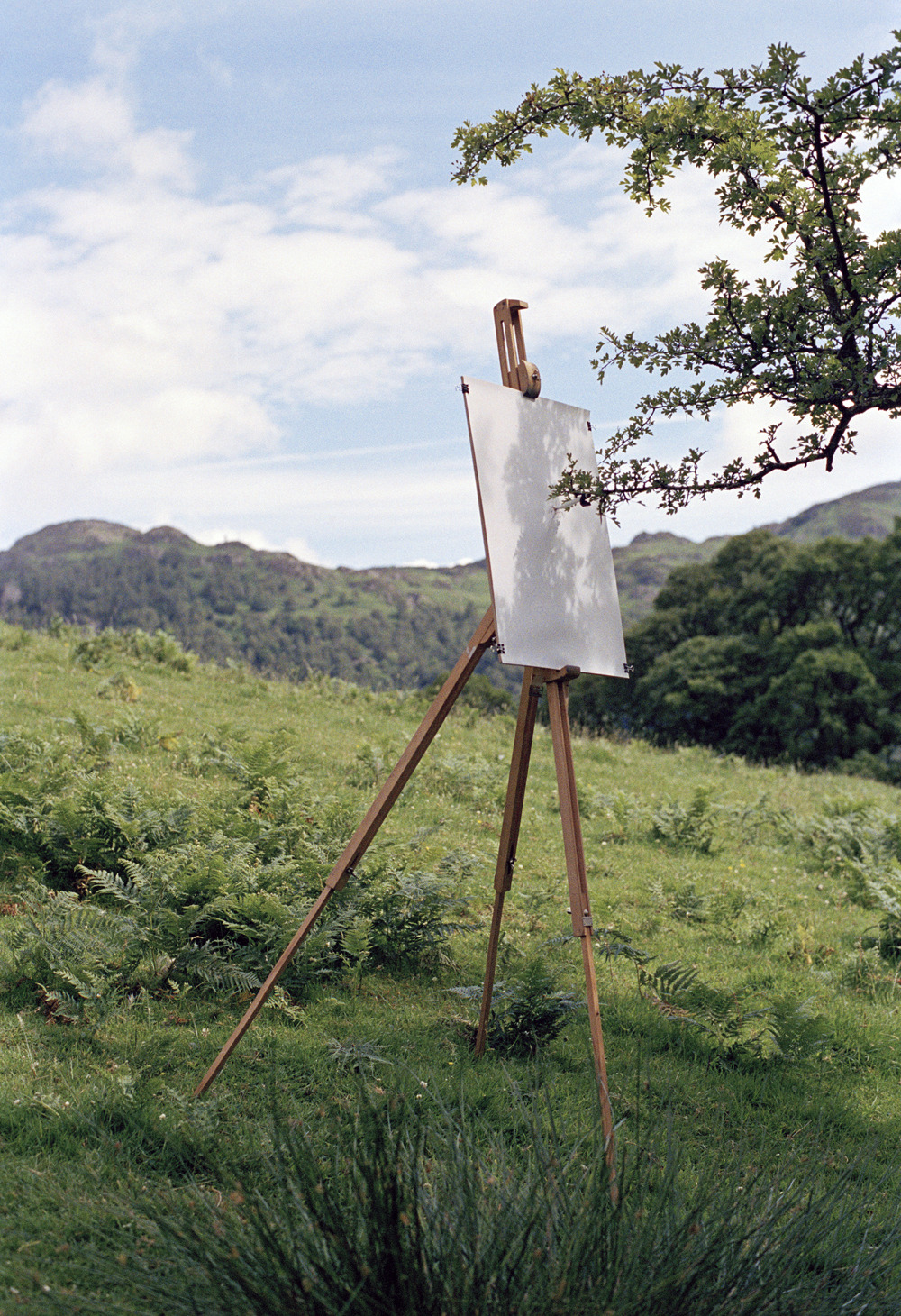
Tim Knowles
Tree Drawings
Tim Knowles est un artiste pluridisciplinaire britannique. Même s’il se défend d’être obsédé par le vent, cet élément a beaucoup inspiré son travail, il aime ses propriétés et son absence de contrôle. Tree Drawing est un très bel exemple du travail de Tim Knowles, il accroche des feutres aux branches d’un arbre et attend que le dessin se fasse sous l’impulsion du vent ou de la brise sur les branches. Ce qui est beau dans cette oeuvre c’est qu’on peut ressentir les propriétés intrinsèques de l’arbre, qui peut être souple, rigide, léger, fragile.

Kimchi and Chips
Difference and Repetition
The title references Deleuze’s thesis ‘Difference and Repetition’ – his attempt to understand reality without referring to identities. The artists aim to ‘unidentify’ the audience – to criticize the bubbles of reality which technology has helped us to build around ourselves. By allowing ourselves to remove our identity occasionally, we can better understand the thoughts of those we disagree with and therefore better work together to build a combined reality. Difference (in both senses) is generated by the motion control system which continuously changes the pose of the mirrors relative to the viewer. This movement disrupts space itself, creating a transformation similar to that of a Lorentz transformation when one travels close to the speed of light. This causes space itself to compress, twist and break, giving the viewer a tool for observing the non-absolute nature of time.
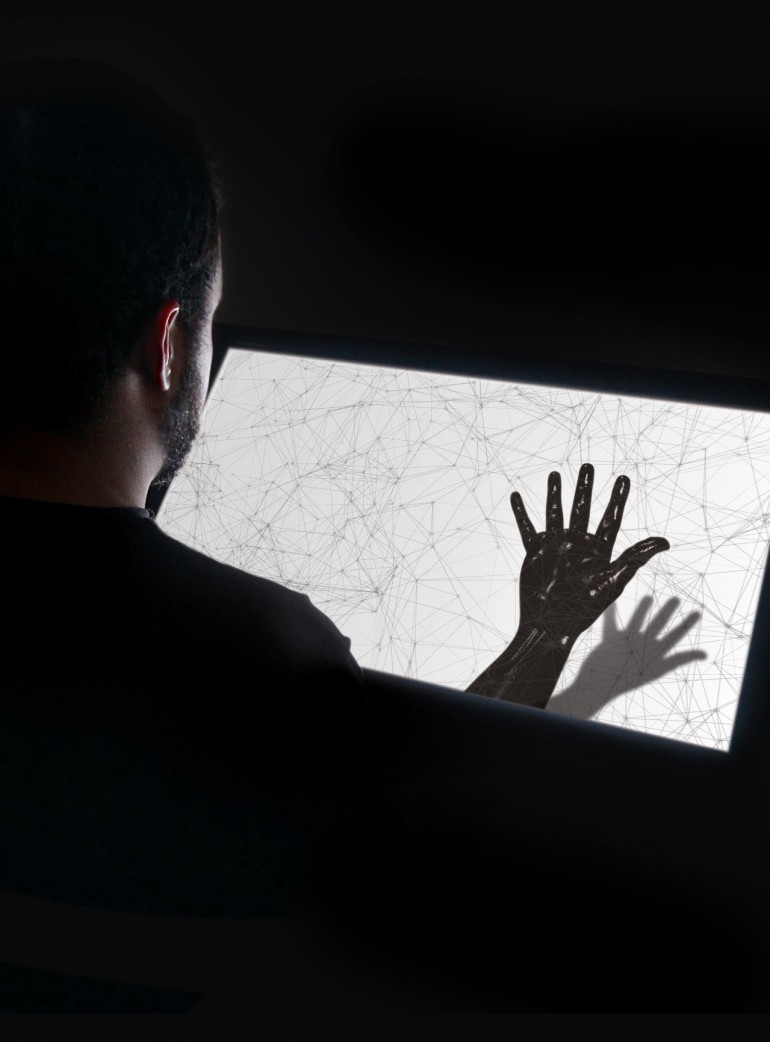
Índice
Jonattas Poltronieri, Luis Mello, Pedro Venetucci & Rofli Sanches
Phantom Limb
Just like the original box, the installation is a rectangular unit where the user inserts his arm and is urged to move it in different ways. The similarity with the original object disappears as, instead of having a mirror to provide the image that motivates the interaction, there is a screen that mediates the user’s view and the place where his arm actually is. The displayed image of the user’s arm can be reversed, distorted and coloured, among several modifications to simulate in a rich way the strangeness of not having control over a member, and to question whether what is seen is an accurate portrayal of the real body. Although deep and subjective, the topic addressed in this experience is easy and accessible in its interaction, offering various sensory feedbacks to the user. Through it, it is proposed that we experience and reflect upon the disconnection between thought and body, intention and action, sensation and reality.

Richard Vijgen
Hertzian Landscapes
Hertzian Landscapes (2019) is a live visualization of the radio spectrum. Unlike visible light, waves in the radio spectrum cannot be perceived by us directly yet this space is teeming with human activity. Hertzian Landscapes employs a digital receiver to scan large swaths of radio spectrum in near real-time and visualizes thousands of signals into a panoramic electromagnetic landscape. Users can zoom in to specific frequencies by positioning themselves in front of the panorama as if controlling a radio tuner with their body, giving them a sense of walking through the spectrum.

Lauren Lee McCarthy
SOMEONE
SOMEONE imagines a human version of Amazon Alexa, a smart home intelligence for people in their own homes. For a two month period in 2019, four participants’ homes around the United States were installed with custom-designed smart devices, including cameras, microphones, lights, and other appliances. 205 Hudson Gallery in NYC housed a command center where visitors could peek into the four homes via laptops, watch over them, and remotely control their networked devices. Visitors would hear smart home occupants call out for “Someone”—prompting the visitors to step in as their home automation assistant and respond to their needs. This video installation presents documentation from the initial performance on four screens throughout the space.

Lien-cheng Wan
Reading Plan
“Reading Plan is an interactive artwork with 23 automation book flipping machines. When audiences enter the exhibition room, these machines will start to turn pages automatically and read the context at the same time. The updated figure to show that average student numbers per primary school in years 2016 in Taiwan is 23 students. I included a metaphor classroom in this artwork. In Taiwan, when people go to school, they don’t have much decision power to decide what they want to read and study. It is like being controlled by a huge invisible gear. The education direction led by authorities always prioritizes industry value and competitiveness. They want create a money-making machine instead of self exploration and humanism thinking.” Lien-cheng Wan

Ying Yu
airmorphologies
Humans, as social beings, use language to communicate. The human voice, as a biometric authentication mechanism, is constantly used throughout daily life applications, such as speech recognition, speaker verification, and so on. Currently, language-based communications mainly fall into two categories: voice over air, and voice over internet protocol. Can we add a new dimension for voice communication such as a wearable material? If so, how could we shape matter in order to physicalize vocal information?
airMorphologiesis an interactive installation that uses soft materials, such as silicon, fabric, and air, to realize these physicalizations. The human voice controls the actuation of a soft wearable structure, changing the appearance of the human body.

ESTHER STOCKER
ЭСТЕР СТОКЕР
에스더 스토커
以斯帖施特克尔
In addition to painting on the usual canvas, Esther Stocker creates her minimal abstract work on entire rooms and structures. The Italian artist has been creating her black and white installations and wall works since 2001, which have been exhibited all over the world. Esther uses stark geometric lines to create a shaken sense of depth perception and spatial uncertainty in the eyes of the viewer, to which she simply explains: “Control is always what we do not have. This is the human condition.”
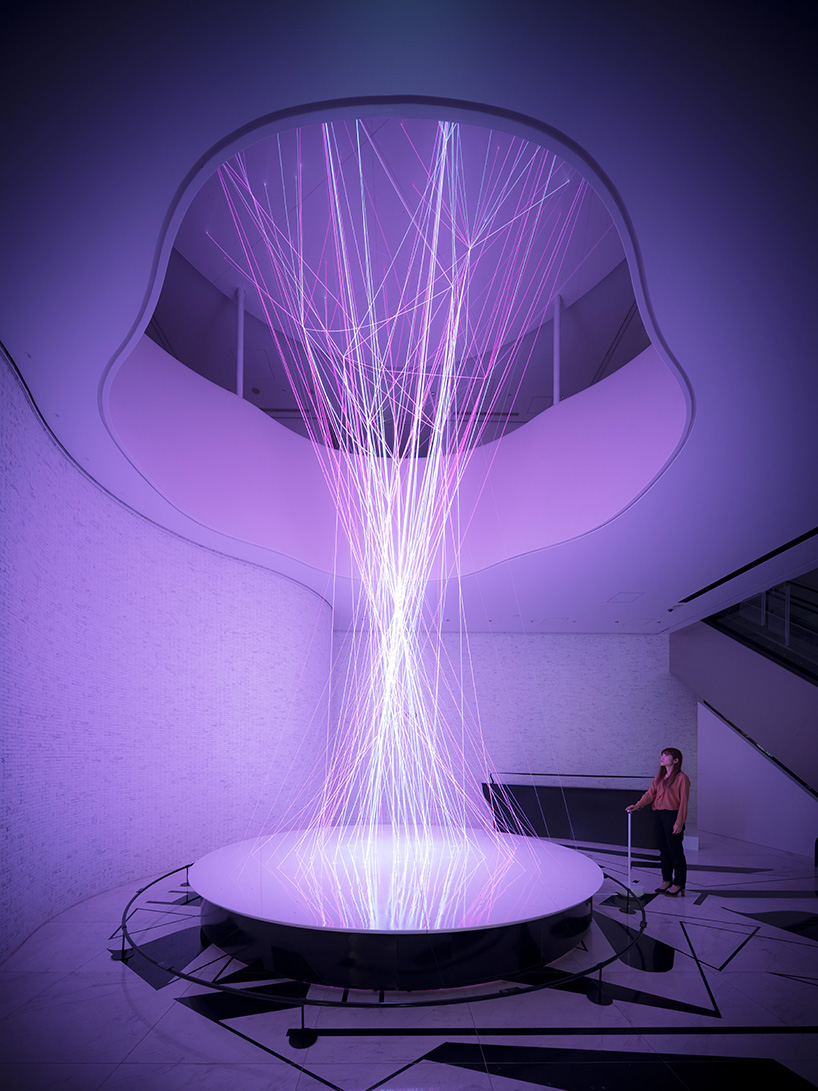
WOW inc
Neuro Surge
Measuring about 9 meters in height, the work pierces through the atrium of the ‘shiseido’ ginza building from the first to the second floor and creates an unprecedented display of light with the use of new advanced fibers. WOW inc. attached 150 fibers with a .9 millimeter diameter to a laser module. The laser module transmits light through the fibers, which can be controlled by touch. The interactive work visualizes the complex transmission of sensory nerves and information into a dynamic light show.

ROSIE DANFORD PHILLIPS
Autumn Winter 2019
Rose Danford-Phillips admits it: as the daughter of gardeners, she draws her inspiration from nature. And when she evokes her love for lace, she speaks about a “delicate sensation of petals” … With her skill at vegetation metaphors, she explains that she transformed a magnificent piece of Sophie Hallette lace into a “rampant vine” for her graduate collection at the Royal College of Art. Either by combining it with a fringed silk to reinforce the idea of an uncontrollable, wild nature or by hand-embroidering it onto plastic to create a sense of nature recreated in a laboratory. “Lace tells a story” she says and hers transports us into a poetic, feminine and modern tale.

CHANG YEN TZU
Self Luminous 2 – Unbalance
Self-luminous 2 is an experimental handmade instrument shown as performance. It is a series-project which I have been working on since 2013 and finally developed into shape in 2014. I am looking for intimate and personal instrument that reflects on the relation of digital sound and light message. In computer language, light on is 1 and light off is 0. If more than 2 lamps, it could be code or readable possibility by the meanings. When I press the button or turn the knob, the message will be sent to Pure Data, and the sound will be triggered in live by Pure Data.
The Data of sound such as frequency and volume, are analysed and sent out to the second Arduino to control the light. The light, in thus case, is an intuitive element for human beings. From this point, it is really close to sound which disturbs our biological body directly. The lights are visualised and they can be transferred the into messages. The message might be readable by coincidence with the link to the code. The light is bright enough to let audience to have persistence of vision in mind. During the performance, the sound will be reproduced by code and part of it is impromptu.
.
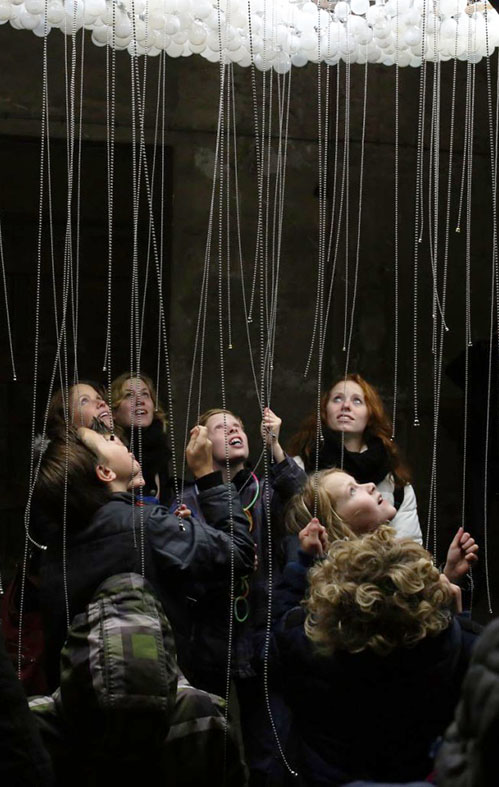
Caitlind r.c Brown & Wayne Garrett
Cloud
The hand-bent steel substructure of the sculpture is covered in a skin of incandescent light bulbs (new and burnt out), and rear-lit from within by 250 compact fluorescent bulbs, pulling a total power of approximately 20 amps (the equivalent of two household outlets ).Each of these bulbs is attached to a pull-string, allowing viewers to control the illumination of the structure – like lightning in the CLOUD above them.

GUY BEN-ARY, PHILIP GAMBLEN AND STEVE POTTER
Silent Barrage
Silent Barrage has a “biological brain” that telematically connects with its “body” in a way that is familiar to humans: the brain processes sense data that it receives, and then brain and body formulate expressions through movement and mark making. But this familiarity is hidden within a sophisticated conceptual and scientific framework that is gradually decoded by the viewer. The brain consists of a neural network of embryonic rat neurons, growing in a Petri dish in a lab in Atlanta, Georgia, which exhibits the uncontrolled activity of nerve tissue that is typical of cultured nerve cells. This neural network is connected to neural interfacing electrodes that write to and read from the neurons. The thirty-six robotic pole-shaped objects of the body, meanwhile, live in whatever exhibition space is their temporary home. They have sensors that detect the presence of viewers who come in. It is from this environment that data is transmitted over the Internet, to be read by the electrodes and thus to stimulate, train or calm parts of the brain, depending on which area of the neuronal net has been addressed.
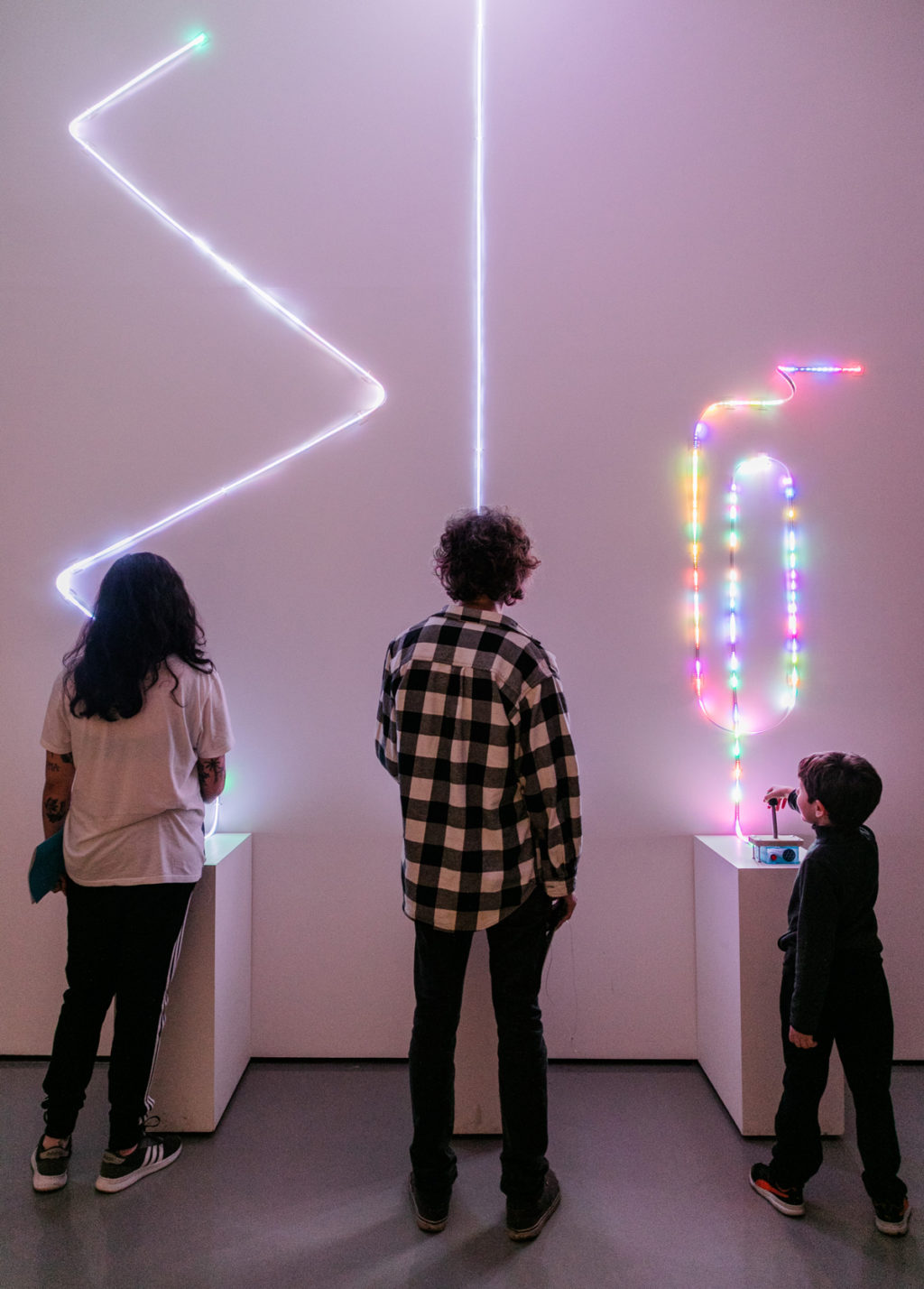
Robin Baumgarten
line-wobbler
file 2019
‘Line Wobbler’ is a one-dimensional dungeon crawler with a custom controller made out of a steel spring and a five-metre long LED strip display. The entire game runs on an Arduino, with sound, particle effects and 120+fps. ‘Line Wobbler’ is an award-winning experiment in minimalism in game design, making use of novel input mechanics, retro sound, and the incorporation of physical architectural space into the game. In the game, players navigate obstacles and fight enemies to reach the exit, in a series of increasingly difficult levels. Movement is controlled by bending the Wobble controller forward and back, while enemies are attacked by flicking the spring at them. Obstacles such as lava fields, conveyor belts and slopes challenge the navigation skills of the player.

Damien Jalet
Skid
Pushing further his exploration of a more intense and intimate relationship of the body to the force of gravity, Damien Jalet created “Skid” (2017) for the Gothenburg Dance Company. The dancers performed for 40 minutes on a 34 degree inclined platform of 40 square meters. Together with dancer Aimilios Arapoglou and other members of the company, they developed an alphabet of new physical possibilities, alternating control and surrendering, of accelerations and slow motions, to be performed alone or with partners.
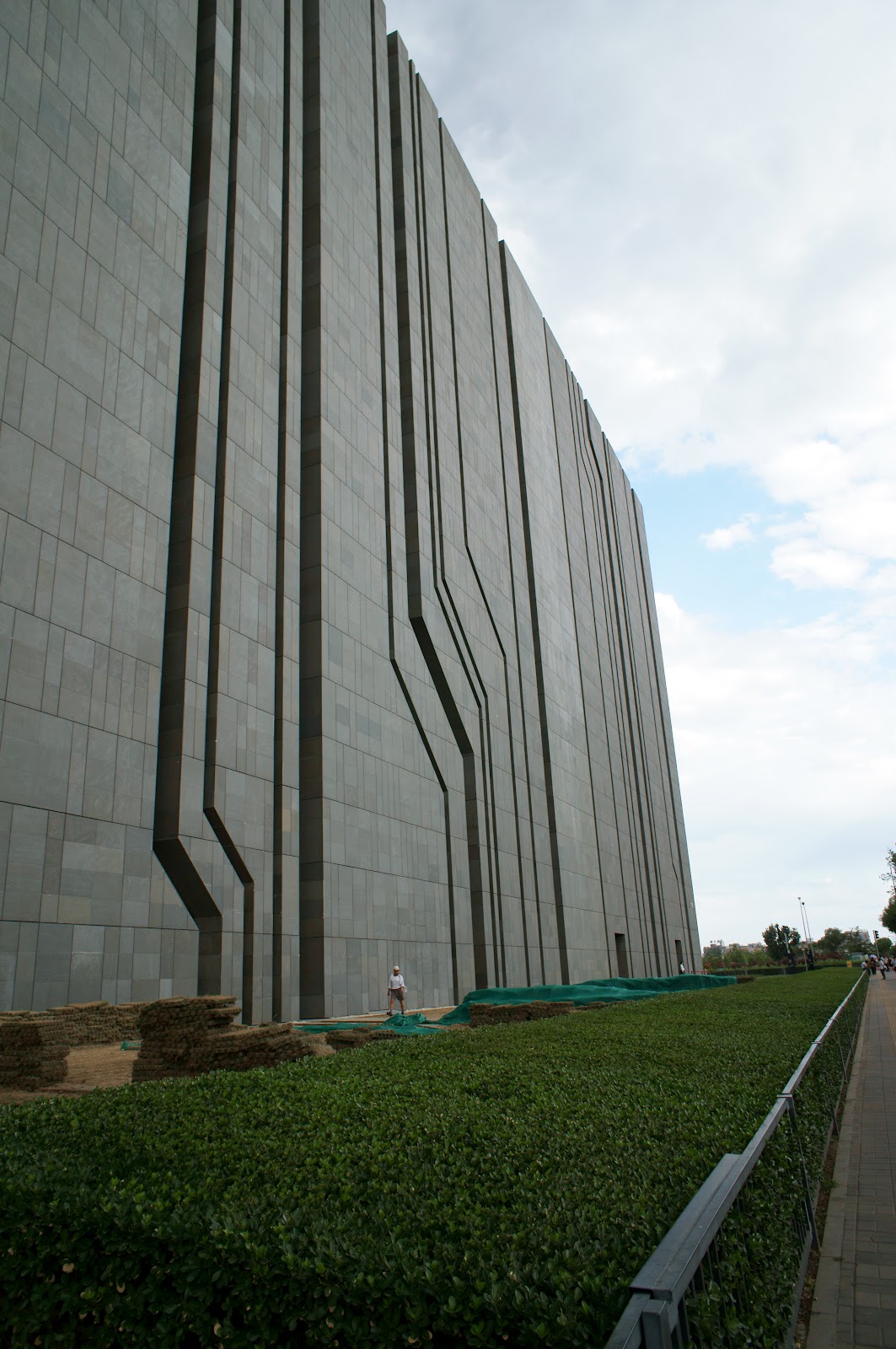
Zhu Pei and UNRBANUS
Digital Beijing
The Digital Beijing building begins to explore what will occur in the digital epoch. The building served as the control and data centre for the 2008 Olympics. The concept for Digital Beijing was developed through reconsideration and reflection on the role of contemporary architecture in the information era. Resembling that omnipresent symbol, the bar code, the building emerges from a serene water surface. The façade itself is detailed to resemble an integrated circuit board.

Desiree Dolron
XTERIORS II
In her ‘Xteriors’ series (2001 – the present), Desiree Dolron reveals her devotion to art history by giving her anonymous models a hint of a resemblance to the works of the Flemish Primitives and Johannes Vermeer. In images which, thanks to her control of light and subtle digital manipulations, hardly look like photographs at all, she produces a masterly approximation of the serenity and sense of mystery with which these painters imbued their work.more…


Hyperchoreography
An interactive installation between dance
L’ipercoreografia è un’installazione video interattiva a sei schermi. Puoi attivare e controllare il video dei sei ballerini nel lavoro con i tuoi movimenti del corpo. Puoi diventare un ballerino o anche un coreografo del lavoro, sperimentando la gioia illimitata della danza e della danza. L’ipercoreografia è un’esperienza emozionante e stimolante che ti offre una panoramica dell’arte della coreografia e dello screendance. L’ipercoreografia è una nuova installazione concepita dagli artisti dello screendance Simon Fildes e Katrina McPherson della pluripremiata compagnia di produzione indipendente scozzese Goat. L’opera d’arte è stata creata in collaborazione con il coreografo tibetano di fama internazionale Sang Jijia, il produttore musicale veterano Dickson Dee, sei ballerini eccezionali e il creativo locale, LazyAnt.
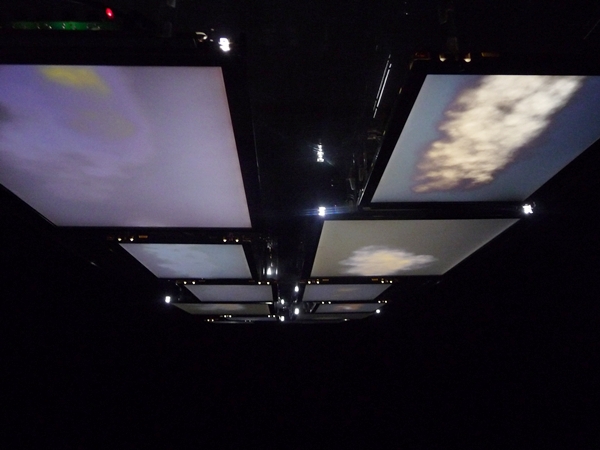
aaajiao
Cloud.data
Created by Aaajiao (Xu Wenkai), a media artist based in Shanghai, cloud.data is an iPhone/iPad app installation inspired by an ancient legend. Using different touch gestures you get to control the passing cloud formations. Single tap allows you to redirect them, double to change their size and three finger drag to adjust opacity. The app is an interactive incarnation of the processing installation Aaajiao created in 2009 (see images).
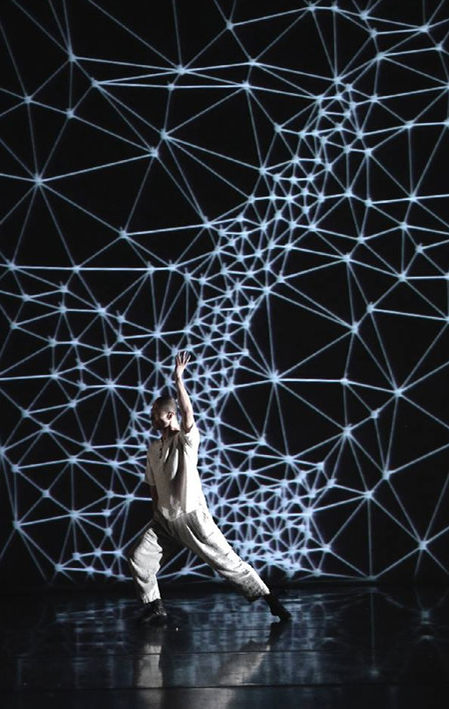
Breakdown
Interactive audiovisual dance performance
via highlike submit
Breakdown is an interactive audiovisual dance performance presented at the Ears Eyes and Feet event in the B. Iden Payne Theater, May 2014, UT Austin Texas.
Breakdown explores a 2 dimensional simulated world in which its physical rules are constantly being changed and manipulated by an external entity. An inhabitant of this world is in constant motion to adapt to its characteristics. He interacts with the physical rules and develops a dialogue with the entity who controls the forces. Eventually the inhabitant ends up breaking the world’s rules and release himself into a new world, a new dimension.

DILLER + SCOFIDIO
The Blur Building (an architecture of atmosphere)
The Blur Building is a media pavilion for Swiss EXPO 2002 at the base of Lake Neuchatel in Yverdon-les-Bains, Switzerland.From piles in the water, a tensegrity system of rectilinear struts and diagonal rods cantilevers out over the lake. Ramps and walkways weave through the tensegrity system, some of them providing a counterweight for the structure. The form is based on the work of Buckminster Fuller.The pavilion is made of filtered lake water shot as a fine mist through 13,000 fog nozzles creating an artificial cloud that measures 300 feet wide by 200 feet deep by 65 feet high. A built-in weather station controls fog output in response to shifting climatic conditions such as temperature, humidity, wind direction, and wind speed.The public can approach Blur via a ramped bridge. The 400 foot long ramp deposits visitors at the center of the fog mass onto a large open-air platform where movement is unregulated. Visual and acoustical references are erased along the journey toward the fog leaving only an optical “white-out” and the “white-noise” of pulsing water nozzles. Prior to entering the cloud, each visitor responds to a questionnaire/character profile and receives a “braincoat” (smart raincoat). The coat is used as protection from the wet environment and storage of the personality data for communication with the cloud’s computer network. Using tracking and location technologies, each visitor’s position can be identified and their character profiles compared to any other visitor.In the Glass Box, a space surrounded by glass on six sides, visitors experience a “sense of physical suspension only heightened by an occasional opening in the fog.” As visitors pass one another, their coats compare profiles and change color indicating the degree of attraction or repulsion, much like an involuntary blush – red for affinity, green for antipathy. The system allows interaction among 400 visitors at any time.Visitors can climb another level to the Angel Bar at the summit. The final ascent resembles the sensation of flight as one pierces through the cloud layer to the open sky. Here, visitors relax, take in the view, and choose from a large selection of commercial waters, municipal waters from world capitals, and glacial waters. At night, the fog will function as a dynamic and thick video screen.
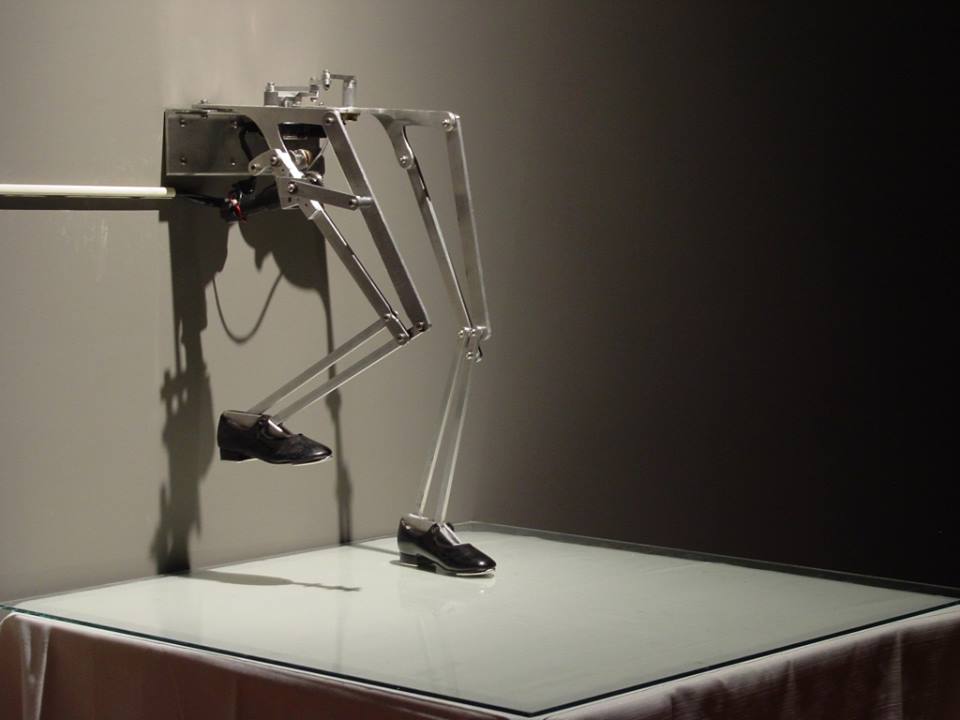
Heidi Kumao
Protest
“Protest” is from the project, “Misbehaving: Media Machines Act Out”(2002-2007), a series of mechanical girls’ legs, each with their own prescribed and programmed behavior. In each tableau, an electronically controlled, mechanical being protests with a voice of erratic physical gestures and projected video imagery. As a combination of robotics and performance, they represent girls who disobey or resist expectations. Unlike machines designed for perfect job performance, these machines will declare their fallibility, impatience, approval, and disapproval through small gestural acts. In these tableaus of protest and transformation, the machine is spirited, emotional, thoughtful, and irregular. “Protest” consists of aluminum, mechanized pairs of 6 year-old girl’s legs fitted with shoes and standing on a table top. An electronic circuit and proximity sensors make her responsive to the presence of viewers for whom she stomps loudly and erratically

JAMES LAW CYBERTECTURE INTERNATIONAL
Cybertecture Egg
Cybertecture is the revolutionary concept that provides a symbiotic relationship between the urban fabric and technology. Pioneered in 2001, Cybertecture forges both the hardware of the built environment and software systems and technologies from the micro to macro scales of development.The genesis of Cybertecture is in response to man’s progress into the 21st century, where working and living environments need to adapt and evolve to cope with the demands of modern working life. It plays an integral part in this evolution by providing awareness and connectivity via seamless integration of technology into the fabric of space.Cybertecture designs, from technology, products and interiors to systems, buildings and masterplans, allow flexibility and accessibility to inform, adapt, react, communicate, manipulate and control environments, whilst being sustainable and environmentally considered in application and context.Cybertecture embraces the future through continuous innovation and evolution of design and technology. It provides a myriad of solutions, all of which are diverse in individual application but holistic to the overall user environment, and always being integrated with innovation being pursued.

Kian-Peng Ong
Coronado
File festival
“Coronado” was inspired by a visit to the Coronado beach in California, which was an awe inspiring moment never experienced in other beaches. The soundscape present in Coronado seemed to be coming from all directions with layers and layers of sound waves. I decided then that I would make a sound work to translate this experience. The sound installation is characterized by the interplay of the analog and digital sound sources which layers over one another, exploring the idea of a seascape. The center of the installation is an ocean drum controlled with mechanical arms that creates and simulates the sound of sea waves. This is picked up by the microphone, reprocessed through the computer and sent out to the 6 channel surround speakers in different time. The interplay and sense of endlessness in the layering the analog and digital are my interpretation and response to the wonderment I found in Coronado.